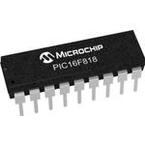DEVICE OVERVIEW
●This document contains device specific information for the operation of the PIC16F818/819 devices. Additional information may be found in the “PICmicro® Mid-Range MCU Family Reference Manual” (DS33023) which may be downloaded from the Microchip web site. The Reference Manual should be considered a complementary document to this data sheet and is highly recommended reading for a better understanding of the device architecture and operation of the peripheral modules
●Low-Power Features:
●• Power-Managed modes:
● - Primary Run: XT, RC oscillator, 87 µA, 1 MHz, 2V
● - INTRC: 7 µA, 31.25 kHz, 2V
● - Sleep: 0.2 µA, 2V
●• Timer1 oscillator: 1.8 µA, 32 kHz, 2V
●• Watchdog Timer: 0.7 µA, 2V
●• Wide operating voltage range:
● - Industrial: 2.0V to 5.5V
●Oscillators:
●• Three Crystal modes:
● - LP, XT, HS: up to 20 MHz
●• Two External RC modes
●• One External Clock mode:
● - ECIO: up to 20 MHz
●• Internal oscillator block:
● - 8 user selectable frequencies: 31 kHz, 125 kHz, 250 kHz, 500 kHz, 1 MHz, 2 MHz, 4 MHz, 8 MHz
●Peripheral Features:
●• 16 I/O pins with individual direction control
●• High sink/source current: 25 mA
●• Timer0: 8-bit timer/counter with 8-bit prescaler
●• Timer1: 16-bit timer/counter with prescaler, can be incremented during Sleep via external crystal/clock
●• Timer2: 8-bit timer/counter with 8-bit period register, prescaler and postscaler
●• Capture, Compare, PWM (CCP) module:
● - Capture is 16-bit, max. resolution is 12.5 ns
● - Compare is 16-bit, max. resolution is 200 ns
● - PWM max. resolution is 10-bit
●• 10-bit, 5-channel Analog-to-Digital converter
●• Synchronous Serial Port (SSP) with SPI™ (Master/Slave) and I2C™ (Slave)
●Special Microcontroller Features:
●• 100,000 erase/write cycles Enhanced Flash program memory typical
●• 1,000,000 typical erase/write cycles EEPROM data memory typical
●• EEPROM Data Retention: > 40 years
●• In-Circuit Serial ProgrammingTM (ICSPTM) via two pins
●• Processor read/write access to program memory
●• Low-Voltage Programming
●• In-Circuit Debugging via two pins


